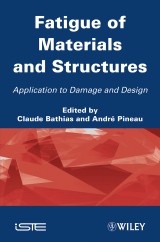Details

Fatigue of Materials and Structures
Application to Damage and Design1. Aufl.
|
149,99 € |
|
| Verlag: | Wiley |
| Format: | |
| Veröffentl.: | 04.03.2013 |
| ISBN/EAN: | 9781118616741 |
| Sprache: | englisch |
| Anzahl Seiten: | 512 |
DRM-geschütztes eBook, Sie benötigen z.B. Adobe Digital Editions und eine Adobe ID zum Lesen.
Beschreibungen
The design of mechanical structures with improved and predictable durability cannot be achieved without a thorough understanding of the mechanisms of fatigue damage and more specifically the relationships between the microstructure of materials and their fatigue properties. Written by leading experts in the field, this book (which is complementary to Fatigue of Materials and Structures: Application to Damage and Design, also edited by Claude Bathias and André Pineau), provides an authoritative, comprehensive and unified treatment of the mechanics and micromechanisms of fatigue in metals, polymers and composites. Each chapter is devoted to one of the major classes of materials or to different types of fatigue damage, thereby providing overall coverage of the field.<br /> <br /> <p>The book deals with crack initiation, crack growth, low-cycle fatigue, gigacycle fatigue, shorts cracks, fatigue micromechanisms and the local approach to fatigue damage, corrosion fatigue, environmental effects and variable amplitude loadings, and will be an important and much used reference for students, practicing engineers and researchers studying fracture and fatigue in numerous areas of mechanical, structural, civil, design, nuclear, and aerospace engineering as well as materials science.</p>
<p><b>Foreword xi</b><br /> <i>Stephen D. ANTOLOVICH</i></p> <p><b>Chapter 1. High Temperature Fatigue 1</b><br /> <i>Stephen D. ANTOLOVICH and Andre PINEAU</i></p> <p>1.1. Introduction and overview 1</p> <p>1.2. 9 to 12% Cr steels 7</p> <p>1.3. Austenitic stainless steels 22</p> <p>1.4. Fatigue of superalloys 40</p> <p>1.5. Lifespan prediction in high-temperature fatigue 104</p> <p>1.6. Conclusions 114</p> <p>1.7. Acknowledgments 118</p> <p>1.8. Bibliography 118</p> <p><b>Chapter 2. Analysis of Elasto-plastic Strains and Stresses Near Notches Subjected to Monotonic and Cyclic Multiaxial Loading Paths 131</b><br /> <i>Gregory GLINKA</i></p> <p>2.1. Introduction 131</p> <p>2.2. Multiaxial fatigue parameters 134</p> <p>2.3. Elasto-plastic notch-tip stress-strain calculation methods 146</p> <p>2.4. Comparison of notch stress-strain calculations with numerical data 164</p> <p>2.5. Conclusion 173</p> <p>2.6. Bibliography 173</p> <p>2.7. Symbols 176</p> <p><b>Chapter 3. Fatigue of Composite Materials 179</b><br /> <i>Claude BATHIAS</i></p> <p>3.1. Introduction 179</p> <p>3.2. Drastic differences between the fatigue of composites and metals 183</p> <p>3.3. Notch effect on fatigue strength 191</p> <p>3.4. Effect of a stress on composite fatigue 193</p> <p>3.5. Fatigue after impact 198</p> <p>3.6. Fatigue damage criteria 199</p> <p>3.7. Conclusion 202</p> <p>3.8. Bibliography 203</p> <p><b>Chapter 4. Fatigue of Polymers and Elastomers 205</b><br /> <i>Claude BATHIAS</i></p> <p>4.1. Introduction 205</p> <p>4.2. Life of polymers 206</p> <p>4.3. Crack propagation within polymers 207</p> <p>4.4. Damaging mechanisms of polymers 208</p> <p>4.5. Specific case of the fatigue of elastomers 210</p> <p>4.6. The life of natural rubbers 211</p> <p>4.7. Crack propagation in natural rubber 213</p> <p>4.8. Propagation mechanisms of cracks in natural rubber 217</p> <p>4.9. Multiaxial fatigue of rubbers 219</p> <p>4.10. Cavitation of rubbers 221</p> <p>4.11. Conclusion 222</p> <p>4.12. Bibliography 222</p> <p><b>Chapter 5. Probabilistic Design of Structures Submitted to Fatigue 223</b><br /> <i>Bruno SUDRET</i></p> <p>5.1. Introduction 223</p> <p>5.2. Treatment of hazard in mechanical models 224</p> <p>5.3. Plotting probabilistic S–N curves 229</p> <p>5.4. Probabilistic design with respect to crack initiation 237</p> <p>5.5. Probabilistic propagation models 245</p> <p>5.6. Conclusion 252</p> <p>5.7. Appendix A: probability theory reminder 253</p> <p>5.8. Bibliography 259</p> <p><b>Chapter 6. Prediction of Fatigue Crack Growth within Structures 265</b><br /> <i>Jean LEMAITRE</i></p> <p>6.1. Prediction problems 265</p> <p>6.2. Crack growth laws 268</p> <p>6.3. Calculation of cracking variables 282</p> <p>6.4. Resolution method of the cracking equations 289</p> <p>6.5. New directions 296</p> <p>6.6. Bibliography 296</p> <p><i>List of Authors 299</i></p> <p><i>Index 301</i></p>
<b>Claude Bathias</b> is Emeritus Professor at the University Paris 10-La Defense. He started his career as a research engineer in the aerospace and military industry where he remained for 20 years before becoming director of the CNRS laboratory ERA 914 at the University of Compiegne. He has launched two international conferences about fatigue: International Conference on the Fatigue of Composite Materials (ICFC) and Very High Cycle Fatigue (VHCF). <p><b>André Pineau</b> is Professor at Mines ParisTech and a member of the French Academy of Engineering. He has published about 300 papers in international journals and edited or co-edited 10 books. His main research fields are phase transformations, fatigue and fracture of metallic materials.</p>


















